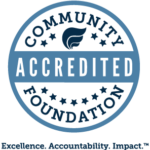Domestic Violence: Breaking the cycle through outreach, education, and economic independence
Oct 23, 2020
Domestic Violence Awareness Month, recognized each October, is a time to acknowledge the victims of domestic violence and to learn about the impact it has on individuals, families, and our community. It also highlights the ongoing work being done to break the cycle of abuse.
The National Coalition Against Domestic Violence (NCADV) defines domestic violence, or intimate partner violence (IPV), as “the willful intimidation, physical assault, battery, sexual assault, and/or other abusive behavior as part of a systematic pattern of power and control perpetrated by one intimate partner against another.” Much more than physical or sexual abuse, IPV can include emotional, psychological, and verbal abuse, as well as reproductive coercion, stalking, and financial control.
More than 10 million Americans, regardless of age, gender, sexual orientation, race, religion, nationality, or socio-economic status, are subjected to domestic violence every year. Last year, nearly 38,000 Connecticut residents sought and received domestic violence-related services from the 18 organizations that make up the Connecticut Coalition Against Domestic Violence (CCADV).
Throughout its 125 years of operation, the Center for Family Justice (CFJ) in Bridgeport has developed a long-standing commitment to addressing domestic abuse, offering “hope, safety, and empowerment” to victims and working to educate and encourage prevention in the community. The first family justice center in Connecticut, CFJ serves Bridgeport, Easton, Fairfield, Monroe, Stratford, and Trumbull, providing critical crisis services to help victims get to a safe environment, legal services to help them navigate the complicated civil and family court process, and ongoing support services to ensure they are equipped with the skills necessary to succeed in a new life free from abuse.
“The ability to be independent, self-sufficient and empowered has a lot to do with a person’s ability to be able to move away from an unsafe situation,” says Amanda Posila, CFJ’s Director of Education and Community Engagement. According to NCADV, 99% of victims report that they experienced some form of economic abuse during their abusive relationship. Perpetrators can limit victims’ access to money, control their financial or basic living resources, coerce them into debt, or prevent them from working or attending school. All of these have a tremendous impact on victims’ ability to gain independence.
“Financial independence and stability is perhaps the single most important factor in helping an individual maximize safety and conversely, lack of financial stability and independence is the single biggest reason an individual may be fearful of leaving a violent relationship.” 1
In fact, finances are often the biggest barrier to ending an abusive relationship. According to one survey, 74% of women said they stayed with their abuser longer because of economic reasons.2 According to the NCADV, 8 million days of paid work are lost every year due to domestic violence and up to 60% of domestic violence victims lose their jobs due to the abuse.3 The impact of economic abuse is far-reaching, affecting victims’ ability to find a job, obtain a place to live, and develop credit history.
CFJ has been a partner and grantee of Fairfield County’s Community Foundation’s Fund for Women & Girls (FWG) since 2001, says Tricia Hyacinth, Senior Director for FWG. The support, says Posila, “has been instrumental in the Center’s growth and development” and helps CFJ develop and run programs that raise awareness of the impact of domestic violence and assist women as they transition to independence. Says Hyacinth, there is a “need for us to ensure that we are helping women to build assets and savings so that they can be independent.”
CFJ provides “wrap around” services to victims of domestic violence to help them deal with the short- and long-term effects of abuse. The Center’s Empowerment and Self-Sufficiency Program helps mitigate the impact of IPV by offering workshops that develop victims’ financial, career/employment, and housing skills that are crucial for success.
“Partnerships with community service providers are critical,” says Posila. This month, in partnership with a New York-based non-profit, CFJ will offer a 6-week personal finance course to clients so they can learn to “budget, set financial goals and save money…, all key barometers of financial success,” and valuable skills necessary as “survivors [achieve] economic security and self-sufficiency.”
Also critical is the need to engage community members, encouraging them to take small steps to inspire change through the national “#1Thing” campaign. This is increasingly important as data show that the need for crisis intervention has risen since March,4 as the pandemic increased risk factors for domestic violence, including isolation, stress, and financial strain. To complicate the issue, public health restrictions made it difficult for victims to reach out for help and for organizations like CFJ to meet the needs of the community while following mandates.
The Center ramped up its outreach to places they knew victims might still have outside interactions, such as telehealth providers, first responders, and food banks, ensuring that service providers were cognizant of the signs of potential abuse, that universal screenings for IPV were happening, and that victims had access to local programs and the state hotline.
CFJ “didn’t skip a beat,” says Posila. With protocols in place, CFJ ensured they could continue to provide “a coordinated, collaborative response” to domestic violence that “saves lives and empowers victims to become self-sufficient survivors.” In combination with the Center’s community-based education, the work to break the cycle of domestic violence is well underway.
Sources:
1. The Difference Between Surviving and not Surviving
2. While Signs Of Economic Recovery Persist, Domestic Violence On The Rise Nationwide
3. Quick Guide: Economic and Financial Abuse
4. The Hotline COVID-19 60-Day Report

